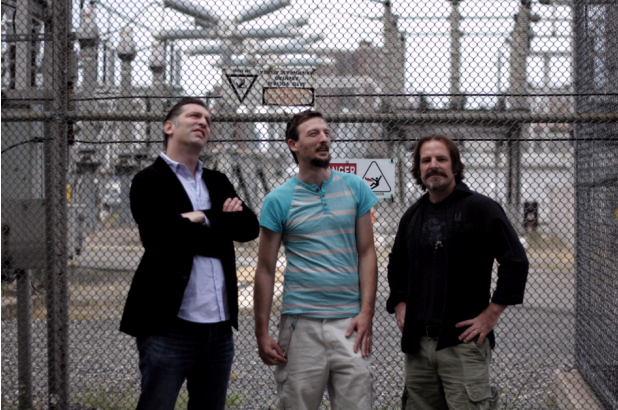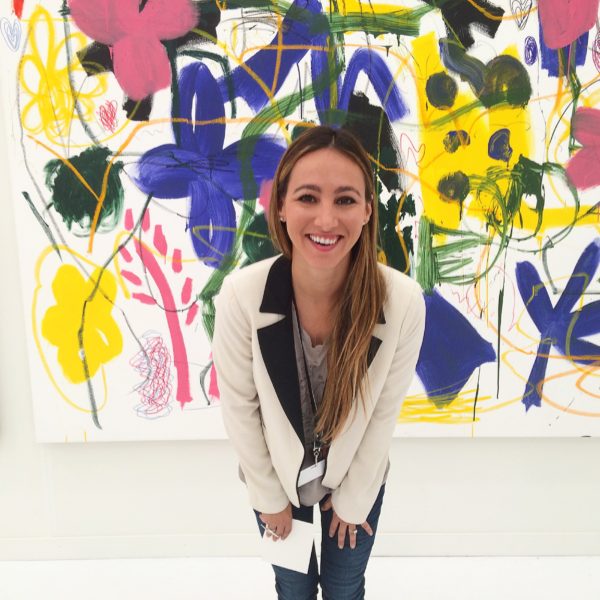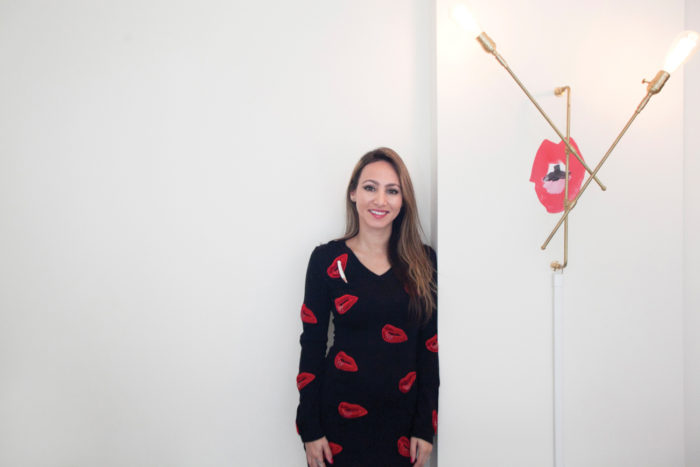Brooklyn’s DUMBO (Down Under the Manhattan Bridge Overpass) neighborhood has long attracted artists and other creative types, and on the first Thursday night of each month, a special neighborhood event celebrates that. Hundreds of spectators gather in the Pearl Street Triangle near the Manhattan Bridge (on the Brooklyn side) to view Light Year, a video presentation of works by innovative digital artists projected onto the side of the bridge.
The presentation, known as LIGHT YEAR, was started in 2015 by longtime DUMBO resident Leo Kuelbs whose goal is to highlight work by Brooklyn-based artists and artists around the world. Kuelbs splits his time between New York and Berlin, where he owns the project space, Fata Morgana. Kuelbs tells Arte Fuse about the success of LIGHT YEAR, how DUMBO became an artist hub, and upcoming shows in New York and Berlin.
Alison Martin: Before Light Year was founded, you’d been projecting work on to the Manhattan Bridge for a while. What are some of the other projects you’ve done and what made you choose the Manhattan Bridge as a backdrop?
Leo Kuelbs: I have actually been presenting video work on the Manhattan Bridge since 2010. I had a couple of basic shows I presented as Leo Kuelbs Collection, then John Ensor Parker and Farkas Fulop from Glowing Bulbs joined in, along with many others, for “Immersive Surfaces” and “Codex Dynamic,” in 2011 and 2012. These were HUGE mapping and single-channel video art projects. Those shows made the careers of a lot of people, but they began with the three of us and grew from there. But what a great venue and our work, along with the foresight of the DUMBO BID [Business Improvement District] and NYC DOT {Department of Transportation] really helped set a tone that is known now all over the world.
I’ve been a resident of DUMBO for about 15 years, so the bridge was always there, always beckoning! It’s a great site for public art works as it is massive, yet still so weirdly personal. I love the Manhattan Bridge, and all of the programming that’s going on there really inspires me and makes me feel happy.
AM: How have people responded to the Light Year shows? Has the attendance grown since you started the event two years ago?
LK: The whole program has grown and has turned into an international phenomenon. I think we have included work by well over 300 artists and curators. Attendance on a per show basis varies, typically depending on how many artists are local or not. It’s ranged from almost no one (during winter) to several hundred people.
But you can never forget how important and meaningful it is to artists from different countries, who have never visited, and may never be able to, visit New York. The comments I hear when I’m traveling and meeting with artists who have participated in LIGHT YEAR are really touching. It reminds me of why I do this. We’re building bridges between cultures – on the Manhattan Bridge in Brooklyn, New York – through the use of video art. It’s a great platform and an honor to be a part of it.
We’re also focusing a little more on the LIGHT YEAR live stream, which happens for 24 hours on the first Thursday of every month. We hope that the LIGHT YEAR vibe can get out there to everyone interested, wherever they are.

AM: Can you tell me when and how you, John Ensor Parker and Glowing Bulbs came to form 3_Search? What is your overall mission?
LK: 3_Search grew out of us working together on “Immersive Surfaces,” “Codex Dynamic,” and two big shows down in Dallas, Texas. It was created as a way to simplify crediting and things like that.
When we began 3_Search, it had a greater scope, but as time went on, we realized that it can be restrictive and isn’t a good fit for certain projects. So now, 3_Search shows are collaborative, public art events, usually in NYC. LIGHT YEAR on the Manhattan Bridge is really 3_Search’s main focus. And we’re also really happy to work with the DUMBO Improvement District and city’s Transportation Department. We’ve had an altogether great working relationship—all of those entities—for over seven years, in one way or another.
AM: Have you always been based in the DUMBO or in the area?
LK: Pretty much since I have been in NYC I have lived in DUMBO. I was in Manhattan for a couple of years and was really happy to get to DUMBO, back in 2005.
AM: What do you think it is about DUMBO that makes it so attractive to artists and people in art-related fields?
LK: DUMBO was a typical “artists first” kind of development scheme, so artists were baked into its DNA. Sadly, almost all of the artists I know have been priced out, and DUMBO Art Center is long gone. But tech companies are happening now and, in general, it’s been a hub for creativity and it still is.
I think the developers understand the need for the vibrancy of creativity and how it attracts attention and thus drives the value of the property. The only problem going forward is where do the artists go once they cannot afford any neighborhood in NYC?
But DUMBO itself is beautiful, and the city and powers that be have done a great job with the amazing and scenic parks. It’s very international, has been featured in loads of movies, and [street artist] Craig Anthony Miller’s work has been a great calling card. When I’m traveling, seeing DUMBO in movies always makes me smile and want to hurry back.

AM: Can you tell me more about what the “First Thursday Gallery Walk” is that takes place in conjunction with the screening? Which galleries do you visit?
LK: The DUMBO BID and the crew from Superfine have done a great job with the First Thursdays programming. I could not be more impressed and inspired. The Brooklyn Americana Music Festival [Sept. 21-24] is also amazing. The biggest thing for me has been the programming (especially music) in the archway. I love it.
The Gallery Walk is also really fun, but I tend to go to the galleries more in the Autumn. I like AIR, Smack Mellon, Usagi—which also has a nice coffee shop. I really like it when September rolls around and the galleries are packed with art students and guests, drinking wine.
Also, the Made in NY Media Center by IFP on John Street is a wonderful place for Digital Art. Their LED wall is one of my favorite things to check out in DUMBO and their screening room has a 2K projector and a killer sound system. When you see video art in that space, it changes into experimental cinema.
AM: Do artists based in DUMBO specialize mostly in digital art or do you see more variety?
LK: I know several painters, a print-maker, and lots of photographers. But, I think most of the artists have moved out of DUMBO. You certainly don’t need an expensive office to make video art, so there are fewer around than in years gone by.
But with LIGHT YEAR and the events at IFP especially, DUMBO is known all over for being a very important hot spot for the support and presentation of video art.

AM: I see you opened up a project space in Berlin called Fata Morgana. What made you decide to open a gallery space in Germany?
LK: I am living part time in Berlin and have had a long relationship with the space that Fata Morgana currently occupies. My German partners (coGalleries and K. Kopietz) and I were able to hold onto the lease going forward, so it was a very rare opportunity to have a project space in Mitte, Berlin, near my flat. It’s a great location. And I can host artists from anywhere in the world. Just a couple of weeks ago, the Austrian New Media artist and Columbia Professor Richard Jochum was staying at my place and having a show at Fata Morgana. It’s a great platform to be able to offer particular colleagues.
Berlin still has a funky economy when it comes to art, but it’s nevertheless a very important city for artists. It is, like NYC, becoming more expensive and artists are leaving, but it still so much cheaper by comparison to cities like NYC. Good food, good night life, nice galleries and some good museums. Centrally located in the heart of Europe!
Also, Berlin has a very complex history with a lot of pain in it. The overall energy dynamic there is so vast. It is sad and attractive and kind of beautiful while also being ugly. It’s a very human city—for better and for worse, I think.
AM: What do you have coming up for Light Year and for the Berlin art space?
LK: Next up is LIGHT YEAR 28: Brooklyn-based on August 3rd. Should be a very fun show with lots of work from my video collection by Brooklyn-based artists. I’m not sure of the exact time, but I invite everyone to Archway Café (57 Pearl St.) for a glass of wine at our pop-up reception!
The curator Erin Joyce is curating September, and We’re also planning an “Oktoberfest” themed show for October. A new show I’m curating (with Aaron Riedel) titled “Identity 0.0” will debut in November. There’s “Digital Fairy Tales: Chinese Stories” happening next year, and a show called “Avalanche!” in the pipeline, as well. And those are just the ones I’m working on personally. John Ensor Parker is bringing great curators on board too.
There’s a show by the Canadian artist Adrian Poccabelli at Fata Morgana coming up in August, then in October, Britta and Ron Helbig are working with Leo Kuelbs Collection for a special show using the “Day of the Dead” as its starting point. Fata Morgana programs in one-week installments mostly, so there’s always something going on, always something worth checking out.





